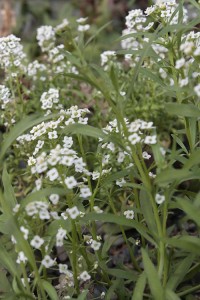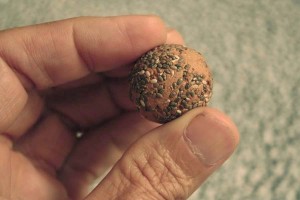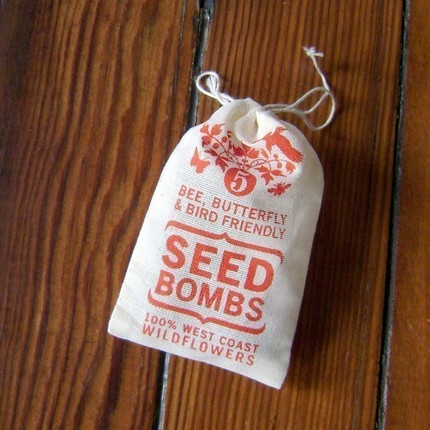Someone has declared tomorrow, October 9, 2010 as International Tulip Guerrilla Gardening Day. [ Here’s the Facebook event. ] I won’t be discussing tulips, but this post does have a few things to say about guerrilla gardening.
The local native plant listserv lit up a few weeks ago over a story in the local paper about seed bombs that ran on August 30.
If you’re not up on seed bombs here’s a little background: The idea of rolling up seeds and clay to make little balls that could be lobbed into an area to sow the seeds probably goes back centuries. But the technique was revitalized in Japan by Masanobu Fukuoka during the last century as part of a low-disturbance style of planting. Instead of tilling the ground, these lumps of seed and clay could be spread out on the earth’s surface, reducing ground disturbance and the resulting need to weed so intensely. Up to that point the little round seed delivery devices were known as seed balls, earth balls or even clay dumplings.
With the rise of the militant guerrilla gardening movement, the little seed ball became one of the weapons of choice against what was perceived as urban blight. An untended vacant lot could be showered with with these little projectiles, and a few good rains could see the seeds sprouting and taking over what might have been invasive weeds. In the testosterone-soaked guerrilla garden movement the friendly seed ball quickly became rebranded a “seed bomb.”
Now we return to current times and the article I started out mentioning: The original cut of the article touted how these particular seed bombs contained native species, including–cue the scary music–sweet alyssum!  While the definitely-not-native sweet alyssum isn’t one of the top two or three most invasive plants, it’s undisputedly a problem and has no business in a seed ball that could get hurled into an wild area by a well-meaning guerrilla gardener. In my own garden, a sowing of the stuff twenty years ago has led to a situation of seedlings still popping up every time it rains.
While the definitely-not-native sweet alyssum isn’t one of the top two or three most invasive plants, it’s undisputedly a problem and has no business in a seed ball that could get hurled into an wild area by a well-meaning guerrilla gardener. In my own garden, a sowing of the stuff twenty years ago has led to a situation of seedlings still popping up every time it rains.
The article generated all sorts of comments, and several people wrote directly to the maker of these particular seed bombs mentioned in the paper, Jim Mumford of GreenScaped Buildings. One thing led to another and it was revealed that the newspaper got hold of a bad list of ingredients, and that sweet alyssum had never been a part of the mix. The newspaper ran a sidebar correction to the story. (The species used to me looks like the California native wildflower mix offered by S&S Seeds.)
Still by that point the damage had been done, and the creator of these particular balls felt like he needed to show up last month at the lion’s den of the the native plant society meeting to do some damage control. He brought us all a big bag of free seed balls. He ran down the real list of species that were really in the mix. He reiterated that sweet alyssum had never been part of the mix.
When it was all over, several in the audience were saying they had no trouble with the species used to make the seed balls. The plants were all from California and weren’t considered invasive. But this was a tough crowd to please and there were still a few lingering concerns.
Within the state there are distinct forms of many of the plants in the mix, and each region’s flora has a particular balance of local plants. If you bring in a non-local strain of a “native” plant you might do something to mess up that balance. Really the only way to make a safe seed bomb that you might lob into a wild area would be to use seed from local plants. Seed bombs are fun, but keep them confined to urban gardens away from wildlands and don’t go tossing the balls into your neighborhood canyon thinking you’re doing the earth a favor.
The story of the San Diego seed bombs has a relatively happy ending. But over the last couple of months I’ve run across a seller who offers “West Coast seed bombs” on Etsy and through a number of boutiques. The vendor lists the ingredients as “Cornflower, Siberian Wallflower, Garland Chrysanthemum, Shasta Daisy, Farewell-to-Spring, Plains Coreopsis, Sulphur Cosmos, Wild Cosmos, African Daisy, Sweet William, California Poppy, Blanket Flower, Baby’s Breath, Tidy Tips, Mountain Phlox, Blue Flax, Sweet Alyssum, Annual Lupine, Lemon Mint, Red Poppy, Rocky Mountain Penstemon, Desert Bluebell, Mexican Hat, Gloriosa Daisy, None-so-Pretty, Prairie Coneflower, and Black-eyed Susan.” Not only does this mix include sweet alyssum, it contains garland chrysanthemum, one of our local scourges. Some parts of the country also have problems with the baby’s breath.
The issue of invasives aside, it makes me wonder about people’s definitions of what constitutes a wildflower. Siberian wallflower on the West Coast? African daisy?
I got in touch with the makers of these seed bombs, and they were quite responsive, saying “we are continually developing this product. Your feedback will help inform our product going forward and is much appreciated. We will gladly include information about the danger of invasive species in our product from here forward.” And they asked for suggestions for plants that would be better citizens in a West Coast wildflower mix. Off the top of my head I referred them to the list accompanying the article, and added just a few ideas of California natives not on the list: baby blue eyes, fivespot, coast sunflower, desert marigold. What others would you recommend?
If the makers of these seed balls drastically change their mix we could have another relatively happy ending. Most of us probably have non-native plants in our gardens. If what happens in the garden stays in the garden, then it’s not quite a doom and gloom scenario. But we definitely have a problem if people start throwing seed bombs into the wilds.
In this case, accompanying the seed balls with a note about the potential threat of invasive plants could do as much good as reformulating the mix.



Wow great post! I’ve loved the idea of the seed bombs since I first heard about them but never really stopped to consider the potential for spreading invasive species. I think since my garden is filled with things I have to baby through the winter and barely stay alive I’ll never have to worry about spreading invasives (what happens in the garden stays in the garden! I love it!). Of course I will forever be battling the Bishops Weed that someone else planted…oh gosh and I did plant Horsetail Rush….but it’s contained!
Shasta daisies (included in that second company’s seed mix) are another non-native that can be a major invasive scourge, at least up here. I bought a seed mix last year that was labeled “California Native Seeds” with no information about which species were in it, and some of the seeds in it turned out to be Shasta daisies – which are absolutely not native! People seem to think they are native because they have Shasta in the name, but that’s like thinking Bermuda grass is native to Bermuda.
I hate the way that non-native annuals are routinely labeled “wildflowers,” but I hate it even more when I make sure to find a seed mix labeled native wildflowers and plant the seeds in little pots and watch them grow and bloom and only then figure out that what I bought still consisted partly of non-native weeds.
How weird that an AFRICAN daisy could ever have got into that mixture!!
Well gee I learned something new as I have not heard of seed bombs. Bummer on the invasive seeds included in the mix. Well meaning folks sometimes just make mistakes. I bet the local seller of those seed bombs will take your advice and fix the seed bombs he/she is selling. As an aside, here in my garden I love sweet alyssum and it has not been a problem here-stays right were originally planted even though I’ve tried to spread it around it will not cooperate with me.
James, I was wondering if you had any trouble viewing my blog? Some readers have said it locks up their computer or is slow-not many but a few. I think I may have too much stuff on it but was just curious. I’ve slowed down a lot but the blog is still kind of congested to put it mildly. I may have to delete a few things. Thanks. tina
Seed bombs are an exciting concept and I have spent time talking to Jim Mumford, as well as others about the idea and how to handle this responsibly.
Once the mix is right and people are educated about the wild lands issue, I think they can implement this with a certain amount of fun. Let’s continue to refine and teach on this and other issues about the role of natives in our communities – from urban to wild.
In my early days of gardening I planted a wildflower mix, and the sweet alyssum and blanketflower were relentless. “Never again!” say I, but the bombs remind me of stories of Miss Wilmott, which always struck me as charming. I don’t know how many packets of Miss Wilmott’s Ghost I have strewn with no results. Did she breathe some magic onto the seeds before she tossed them?
I received some seed balls of CA natives from a friend last year. They managed to sprout, but all dried up quickly, making me wonder how viable most of those seed balls/bombs are.
Regardless, I agree with you. Let’s keep them in the city. Though timing is everything. I sowed some clarkias in an empty lot last year, only to see people with herbicide do the whole area a few months later…
Loree, maybe a seed ball made of wimpy plants that need total coddling is the safest thing to assemble. I know there are dozens of non-native plants in my garden that would stand roughly a zero percent chance of survival away from my house.
Gayle, I knew Shasta daisies were Luther Burbank creations using stock from Asia, but I didn’t know they were problematic spreaders. Very good to know! I ran across a website a few weeks ago on “wildflowers,” and they include lots of naturalized weeds. The site treats the weeds neutrally, as any native plant, and the organizing force behind the site seems to call any plant that grows wildly out of control a “wildflower.” I was hoping to point to it as part of the problem, but I haven’t been able to find it again.
EE, how surprised I was too! Definitely a generous interpretation of wildflower.
Tina, alyssum seems to really be adapted to Mediterranean climates like mine, so I can see it might not be such an enthusiastic grower in Tennessee. As far as your blog, no, I haven’t had any trouble viewing it. It comes up like a charm. If anything I might look to see if anything is going on where the blog is hosted that’s causing the slowness.
Susan, I’m glad you’ve spoken to Jim Mumford about these. In the end the economics of a single commercial product seem to to collide with wildland botany. Can you imagine site-specific seed bombs for each of the dozens of habitats in this county alone? That’s where home projects can really shine compared to products with a wide distribution. Wouldn’t it be great to have a party to make seed bombs using only local-source seeds?
Ricki, at least my blanketflower hasn’t been as relentless in spreading as the alyssum has been, but that’s maybe Southern California versus Oregon. Miss Wilmott’s Ghost might be the perfect seed bomb seed, at least as far as not being something that would germinate in the first place to ever become a problem.
TM, the manufacturing process of the balls involves mud and water, so I can see that getting seed wet can take a bite out of viability. As far as the clarkias, too bad about the herbicide–That’s a bummer of a story! It’s hard to get motivated to do any sort of positive guerrilla gardening if someone just goes in after you with a drench of Roundup.
I can show you a website that’s part of the problem! I was already irritated enough at seeing that non-natives are routinely sold everywhere under the label of “wildflowers,” but I find it even more irritating that sites like this one sell seed mixes specifically labeled as California wildflowers that are also largely non-native, just selected as being easy to grow in California or in specific parts of California. The fact that a non-native is easy to grow is, of course, not necessarily a good thing.
That is the website of a nursery that I actually live near and have purchased native plants from. I suppose I have to give it some credit for the fact that it sells natives at all (both native seeds and native plants), since so few other nurseries do, and for the fact that their “California wildflower” seed mixes do at least contain some native species. But I wish they would just describe their seed mixes as being drought-tolerant or something, rather than as being particularly well-suited for growing in California, because the non-natives really aren’t particularly well-suited for growing in California.
What an interesting and informative post, James. This was my first introduction to the concept of “seed bombs.” I wonder if this is a case where a local ecological model is in conflict with global business models. It will be interesting to see whether businesses that are trying to market seed bombs are willing to take local conditions/local native plants into account in their production and marketing processes.
really interesting post! I guess well-meaning guerilla gardeners (or gardeners in general) need to think about/know what they’re doing – these things could have some serious consequences.
The newspaper “got hold of” a wrong list…lol. The company gave them that list, if it was wrong it was wrong, but guaranteed it came from the company.